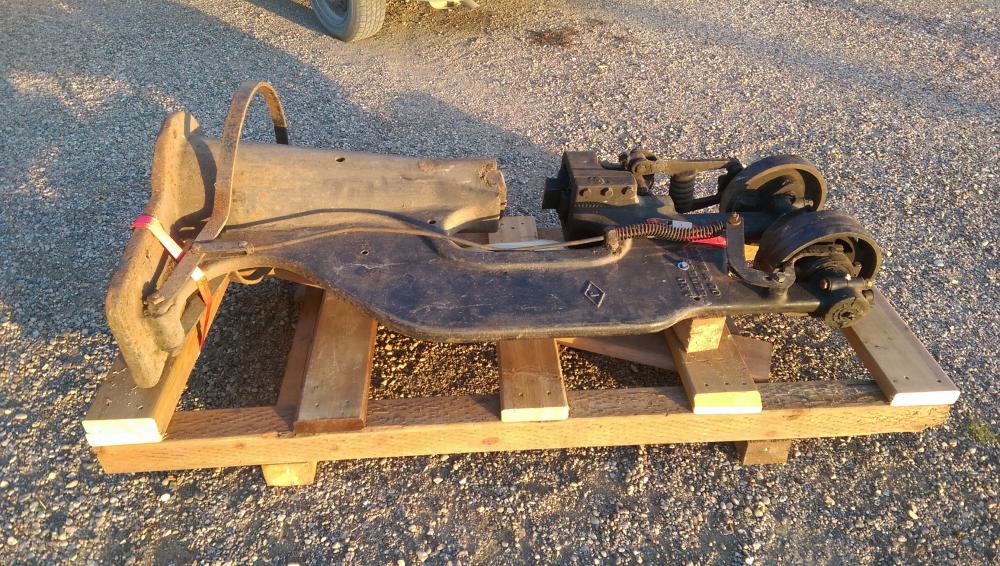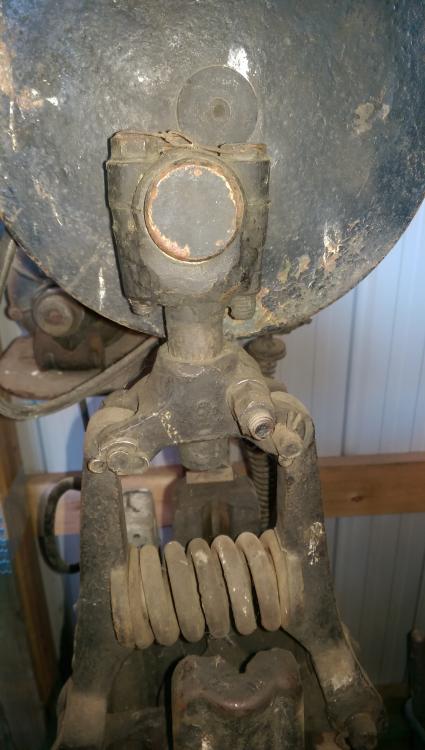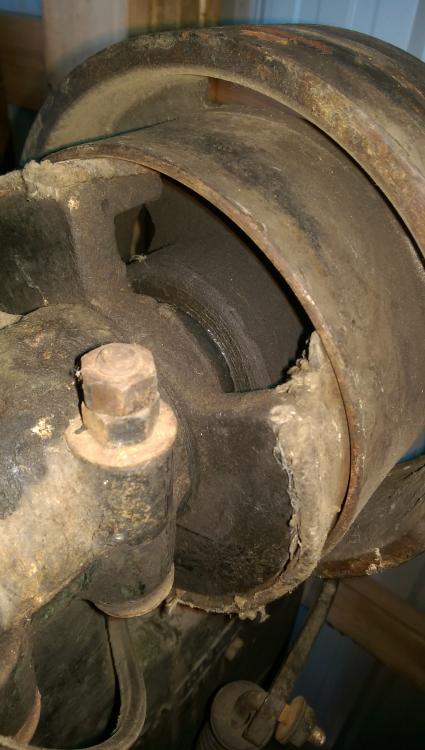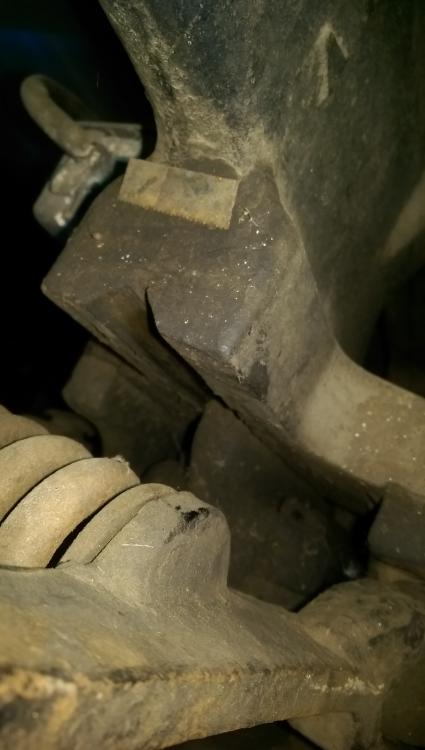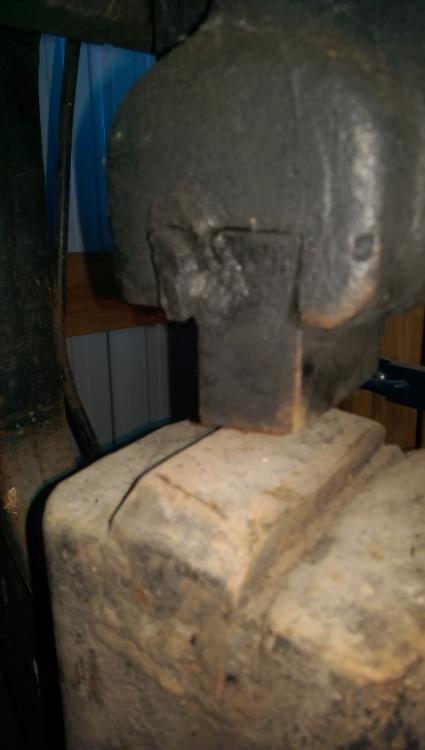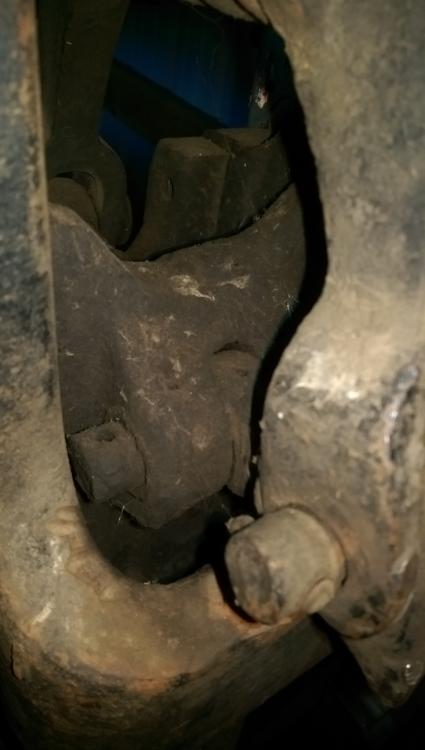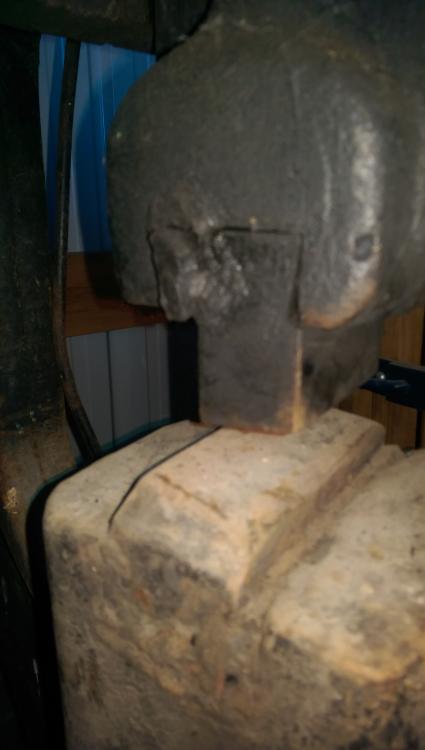-
Posts
99 -
Joined
-
Last visited
Content Type
Profiles
Forums
Articles
Gallery
Downloads
Events
Everything posted by Krush
-
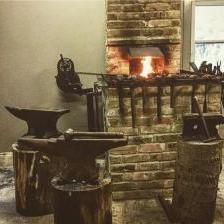
Industrial Ajax Spring hammer HP?
Krush replied to Krush's topic in Power Hammers, Treadle Hammers, Olivers
thanks guys for the great responses, id like to know more about them, i found a couple of great items on them but nothing regarding horsepowers. looking forward to having mine running, i figure about 12 more hours of fab and assembly time and i should have it running. not going to use the slack belt that drifts to the inner flywheel setup but make an idler pulley setup for it like bradley upright compact hammers had instead. i will get some pics of the setup this afternoon and post them. in the meantime heres a neat little article I found on them with a little bit of info. the Lasko and Ajax hammers and one listed in that article are all built in same manner but the Hungarian style hammers look to have some of the drive components built inside of the hammer. I will be looking for a 5 HP 220 motor. I dont want to tax a 3 hp motor or be disappointed with performance. ajax hammer.pdf -
Hi all, I am in the process of rebuilding my Ajax Spring hammer. basically the same thing as a Appalachian hammer but industrial built and very heavy. Its a 100 pound Ram on the hammer and im wondering what Horsepower it would need to run properly. Ive scrounged everywhere I could for a clue but dont read czech or german so coming to dead ends. I have a 3 HP 1750 RPM motor but dont know if it will be sufficient or would be pushing the motor too hard. if anyone knows it would be a real help, even if someone with a 100 pound Bradley or Beaudry Strap or helve hammer could let me know as thats probably the most comparable to my hammer.
-
Thanks all for the kind remarks, ive been running a little here and there the last week and im happy with it, i put a bit of a hood sticking out from the brick over the opening to prevent soot from going on the brick. once the chimney warms up it draws very well but need to burn a bit of paper in it at the start but i kind of expected that considering i was under sizing the flu a bit. im quite happy with the firepot. i always worked with a tuyere in the past but the interchangeable firegrates i really like as i switch it out for whatever type of fire i want. the slotted grate for a low but wide fire and the pipe cap one with the circle of 3/8 holes in it for the focused tall fire. I know you can accomplish the same effect with a tuyere depending on how you build your coal fire but i find the interchangeable grates naturally lend themselves to make certain fire patterns. I will take a couple pics of it running next time im in the forge!
-
I'm fortunate to have a good friend who bartered his labor to do the brickwork for my labor to help him make specialty stone chisels and hammers. i like leaving the government out of a deal when possible.
-
Finally got my permanent forge built, nice centerpiece to the shop, all reclaimed brick. I built a smoke shelf into it and lined the inside of the brick chimney to hold heat and improve convection. I only hooked into the 7" wood stove chimney flue but had done that with my previous temporary forge and it worked perfect so duplicated the design with the brick forge and worked a charm. I know you should use 10 or 12 inch diameter for the flue because the coal forge does not put out the same flu gas temps but it worked just fine. I built the fire pot out of 1/2 inch mild steel with interchangeable inserts for a slotted fire grate and a 2" black iron pipe cap with 3/8" holes in it. the slotted grate gives me a low but wide fire good for pans and large objects where as the pipe cap with the holes gives me a focused and taller column which has turned out really good for working smaller items in the fire. I've heard arguments as to mild steel or cast being better, after having built one I feel they were cast for expediency as building the fire pot took a long time to cut, scarf edges and get good weld penetration and enough of it. anyways lots of fun and it turned out better than I had Imagined.
-

Champion no.1information
Krush replied to mitchell's topic in Power Hammers, Treadle Hammers, Olivers
that'll be an exciting one to see running! -

Champion no.1information
Krush replied to mitchell's topic in Power Hammers, Treadle Hammers, Olivers
Really happy for you! I have a 75 beaudry and a 65 KG ajax federhammer but the price that baby was listed at i was thinking of purchasing it. That unit will be a real gem when you have it up and running! -
yes im pleased, even more that i just measured up my sow block and figured out i can rework the dovetails on my small milling machine. wish my 100 pound Ajax federhammer anvil would be that easy but its 24" tall 14" wide over 800 pounds of anvil. i will be hand working that til next spring.
-
your right it must be a 75pound rated hammer as on the back of the flywheel there is a number 75 in the casting, that along with the confirmed actual weigh in at 86 pounds im pleased that i traded a 25 pound little giant for it. just need to do some dovetail cleanup on the lower sow block and mount motor with jackshaft and she be ready to roll
-
i find it strange that a fifty pound rated hammer would have an 86 pound head. i can see 10 or 12 pound difference but 36 pound seems to be way off but i did weigh it 2x to make sure it was correct. would be interesting to know what that big beaudry is. wonder if that was common with beaudry of if my hammer is just an odd duck!
-
interesting, good to know!
-
just pulled the ram out of my no 2 Beaudry hammer, degreased and tool dies out. The number beaudrys are rated to be a 50 pound hammer but when I weighed my ram it came in at 86lb! machine says no.2 on it but thought id weigh the ram and came in at higher than i expected. should have a real wallup when shes mounted and running.
-

hydraulic motor driven little giant Hammer
Krush replied to Krush's topic in Power Hammers, Treadle Hammers, Olivers
thank you basher, im working with a local hydraulic supply guy. he has built compactors and other hydraulic equipment and has been great as a resource in helping me figure out how to do what i want. -

hydraulic motor driven little giant Hammer
Krush replied to Krush's topic in Power Hammers, Treadle Hammers, Olivers
thanks for the replies, it is taking time to be thorough and get it right the first time, gotta make sure i dont run to close to the kickout pressure for highstage psi on the pump or may have to explore the option of running the high psi unit with low volume, getting the right hydraulic motor for moving the mass will be key in this and i think the starting point. i want to make the powerhammer a 100lber ram with LG style linkages so if they run off a 3hp electric motor i have to figure out what will be an equivalent in hyd. motor roughly and then i will go even a little larger just for good measure. Plan is to have a 5hp electric motor running the 2 stage pump and run the hydraulic press along the spine of the hammer mast and a telescoping mast with adjustable gibs and a hydraulic cylinder for lifting and adjusting throw height of hammer. this way i will have an infinitely adjustable hammer similar to the DP hammers without a bottle jack or bolts to tighten and untighten and no treadle adjustments. just turn on main hammer walk to back of hammer and use valves to operate the press and walk to front use treadle valve to operate hammer and a valve on the side for simple raising the mast up and down via the cylinder. this is the goal anyway, i wont be happy with anything else if i dont achieve that. I want it to be a truly utilitarian tool lot of farmgineering going into it before i start. for sure appreciate the response, looking at it from different angles will give me the best perspective on how to solve the problem -
I am designing a little giant style hammer similar to the DP hammers that move up and down the mast. i plan on building mine on a mast that is mounted in a box with gibs to raise and lower the height of the entire mast on the fly using a hydraulic 2 stage pump with a 5 horse electric motor with a cylinder connected to the mast and main frame. i can use the pump system to lift and lower the ram assembly and will run a smallish hydraulic press of the back of the unit with everything built into one animal. i want to setup the hammers flywheel drive using a hydraulic gear motor. Ive seen it done on another site where the fellow used a 6 cubic inch motor running an eccentric shaft for an appalachian style hammer and ran the pump at 500 psi getting 300 bpm with an 85 pound hammer head. now that ive thoroughly confused all of you does anyone know if a 2 stage pump could do this? if its staying in the high volume (13gpm) stage which runs from 0 - 600 psi (the ones ive been looking at) and kick into high pressure stage anything over 600psi? Another question because i am not as proficient with hydraulic engineering as id like does anyone know what rpm, pressure or flow a 6 cubic inch gear pump motor would need to be for this application? theres alot of selection out there and i want to make sure i go with the right one. ive tried registering on the other site to contact the fellow who created the appalachian style unit but unfortunately to no avail. Please enlighten me if you know anything on the hydraulic motor and 2 stage pump. thanks!
-

25 pound little giant die block repair or replace?
Krush replied to Krush's topic in Power Hammers, Treadle Hammers, Olivers
Thank you, completely done with a grinder, welder and hand files. no milling or lathing, no doubt that would have expedited some of the work and made it flashier but you can do nearly all of it with relatively basic tools. love that about the LIttle Giants. -

25 pound little giant die block repair or replace?
Krush replied to Krush's topic in Power Hammers, Treadle Hammers, Olivers
thank you for the responses, i ended up using the abrasive disc with skil saw method and then finished with a long mill file by hand upper and lower turned out very well. I've stripped the hammer right down to nothing over the winter and cleaned repaired and replaced everything top to bottom. just have to finish my lower die and shes ready to move some metal. I fabricated new pit-man, cross-head, toggle arms, spring retainer, Toggle links, gouged out and re-welded the hammer and welded up the ram ways on the hammer then ground down and shimmed main shaft and the ram guides over the winter. Its been really rewarding and I wouldn't hesitate to do it again for another hammer. lots of fun! attached are a bunch of pics before and after repair. thanks for checking it out. 25_Pound_rebuilt_little_giant.MOV -

25 pound little giant die block repair or replace?
Krush replied to Krush's topic in Power Hammers, Treadle Hammers, Olivers
i will have to look for that thread, im in mid western ontario but theres a guy next door with all the equipment to help me do the job too, it was a machine shop during WW2 where they made bomber airplane parts. thanks for the tip, will see what can be dug up. -

Well-designed guided helve hammer
Krush replied to Stormcrow's topic in Power Hammers, Treadle Hammers, Olivers
Torbjorn was kind enough to send me a bunch of dimensions on that hammer, I was and still am considering building a helve hammer and would build it as close to the abno as possible. the best designed helve style ive ever seen -

25 pound little giant die block repair or replace?
Krush replied to Krush's topic in Power Hammers, Treadle Hammers, Olivers
i measured and theres enough room to cut off the sides of the dovetails and get flat in relation to the ram slides but I agree that the cast iron may not be fond of being threaded and havig bolts pulling a plate down on top, probably call roger rice end of week -
Hi all, im in the middle of rebuilding an old little giant, original style that didnt have the replaceable sow block. Im making new toggle arms and dogbones as well as welding up and reworking the ram slides. problem im looking at is where the lower die sits. My hammer has old beads of weld laid down in there and they are cracked and lifting up i saw a good article on how to utilize a skil saw to get close and then just use blue and hand srape or dremel to resurface and get back to flat and level then shim it from there. im considering just taking off the top parts of the dovetail side and milling down until i get a flat surface right across the top and then get a block of 4140 for a cap and then bold it into the remainder of the the hammers original sow block (casting) then making dies that just bolt onto the top cap of the 4140. I worked on large presses and hammers in the past and that is how all of our tooling was put together and it held up and repeated blows and vibration and tonnage so Im confident it would work but im concerned about the depth of the casting on the original, does anyone know how deep it goes below where the die originally sits? my only concern is not having enough wall thickness and cracking the base, if thats a risk i will repair with known method of scraping and grinding. i prefer to bolt the dies in and i dont care for the die tapered keys but if thats the safest route for the hammer i will go that way. the pic is of the upper and lower dies before i got them out. the ram is ok but like i said the lower will need work, it was welded in there anyone have any experience or thoughts, words of wisdom
-
i wonder if the wifey left him before or as a result of the rubber band fetish
-
I have a 25 pound Canadian Giant arriving friday and refurbishing it over the winter. Anyone else know if the rebuild videos or books are available from a canadian supplier? Im happy to pay Roger Rice or Pieh Tools for either or but the shipping costs are silly. Just wonder if theres a supplier here who possible carries the video or book that I can avoid the prohibitive cost for shipping. I will go the expensive route if necessary but would rather not.
-
thanks patrick i will see what i can dig up on that chart, i understand the velocity play a part in what can be done one the speed you try to move material also plays a role as there is material resistance when trying to move steel quickly like with a hammer or a standard press compared to a linkage drive press or a hydraulic press. my specific question was just in regards to build a homemade hammer. i wanted to understand if there is any value in building a heavier ram which if its a mechanical hammer will have more moving around in comparison to building a smaller ram head and ideal ram weight if i can get the same job done. If i can dig up the info from chambersberg i will see if an old contact of mine who was a hammer designer for AJAX hammers may be able to clarify. thank you interesting paper Judson thank you for posting it My last post is kind of incoherent! Im going to build my own hammer so want to ensure i maximize energy efficiency and lose as little through the anvil as possible. Im definitely going to look for the chambersberg info and see if one of my old contacts at AJAX can help me with any other outstanding questions i might have thereafter.
-
I see homemade hammers all the time with heavy rams but usually they fall dismally short of the 25:1 anvil to ram ratio targeted for optimum efficiency, this ratio doesn't include the total hammer weight. Question : will a 50lb hammer (ram) with a 1500 lb anvil do the same work as the same hammer with a 100lb head and a 1000lb anvil? i am questioning the value of making a 100lb hammer with all of that extra ram mass getting thrown around if the anvil is only 10 times the ram weight. i believe it would be more prudent to invest the money in the optimum anvil weight of 1500 pounds for a 50lb. ram weight if i have better efficiency. Any engineers please speak up if there is any value to building a larger hammer without the best anvil ratio

